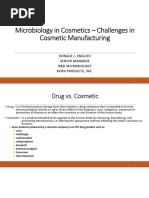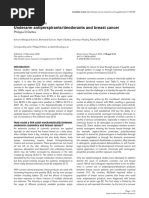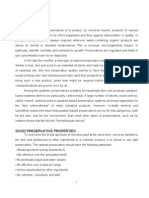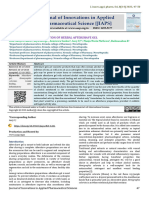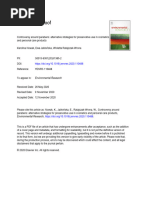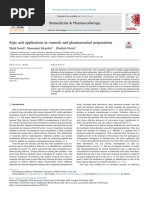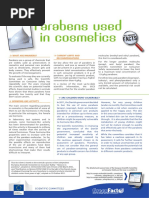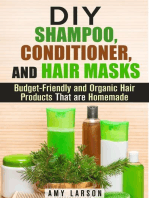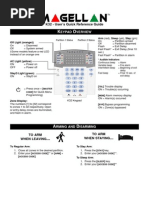Determination of Methyl Paraben From Cosmetics by UV Spectros
Determination of Methyl Paraben From Cosmetics by UV Spectros
Uploaded by
Degus WidianaCopyright:
Available Formats
Determination of Methyl Paraben From Cosmetics by UV Spectros
Determination of Methyl Paraben From Cosmetics by UV Spectros
Uploaded by
Degus WidianaOriginal Title
Copyright
Available Formats
Share this document
Did you find this document useful?
Is this content inappropriate?
Copyright:
Available Formats
Determination of Methyl Paraben From Cosmetics by UV Spectros
Determination of Methyl Paraben From Cosmetics by UV Spectros
Uploaded by
Degus WidianaCopyright:
Available Formats
Int. J. Pharm. Sci. Rev. Res., 59(1), November - December 2019; Article No.
04, Pages: 17-21 ISSN 0976 – 044X
Research Article
Determination of Methyl Paraben from Cosmetics by UV Spectroscopy
Trupti Bhandari,* Dr.Alisha Patel, Khyati Dhodi, Zalak Desai, Saloni Desai
Department of Pharmaceutical Quality Assurance, ROFEL Shri G. M. Bilakhia College of Pharmacy, Vapi, India.
*Corresponding author’s E-mail: truptibhandari10897@gmail.com
Received: 05-09-2019; Revised: 23-10-2019; Accepted: 29-10-2019.
ABSTRACT
This experiment is used for the determination for to estimate the concentration of methyl paraben in cosmetics. Methyl paraben is
an antimicrobial agent, preservative, flavouring agent. The European Economic Community (EEC) Directive stipulates that parabens
are permitted in a concentration of up to 0.8% in cosmetics, with a maximum concentration for each individual one of 0.4% (w/w),
expressed as p-hyroxybenzoic acid. Effectively of parbens in high concentration causes cancer, genotoxicity and breast cancer.
Specifically for methyl paraben caused contact dermatitis and drug hypersensitivity. So, need to determine the concentration of
methyl paraben in cosmetics. The simple, rapid and sensitive UV spectroscopy method was developed for the determination of
methyl paraben in cosmetics products. Methyl paraben maximum absorbance at 254 nm. The extraction of Methyl paraben in
cosmetics may used cream, shampoo and lotion the optimal extraction solvent is methanol. The validation parameter of Methyl
paraben studied the Y= 0.081x+ 0.011, R2 = 0.9940. LOD and LOQ were 0.3095 and 0.9378.
Keywords: Methyl paraben, UV spectroscopy, cosmetics, validation.
INTRODUCTION stipulates that parabens are permitted in a concentration
of up to 0.8% in cosmetics, with a maximum concentration
M ethyl paraben other name is a 4-
hydroxybenzoate (methyl 4-hydroxybenzoate).1
It is the most frequently used antimicrobial
preservative in cosmetics and flavouring agent. .
Methylparaben is found in alcoholic beverages.
for each individual one of 0.4% (w/w), expressed as p-
hyroxybenzoic acid.3 Personal care product, such as hand
cream, facial cleanser and moisturizer, are widely used in
people’s daily lives. But parabens may be added into these
products during the production. It can be absorbed
Methylparaben odourless, small colourless crystals or
through the skin into the body.6 Antimicrobial
white crystalline powder Freely soluble in
effectiveness must be demonstrated for all products for all
alcohol, methanol, acetone, ether.Error! Reference source not found.
products contain antimicrobial preservatives and for
Instance paraben is now used for preservatives in food,
multiple dose topical dosage form and that is because the
pharmaceuticals and cosmetics, daily used the products
concentration of an antimicrobial preservatives may
that continue of methyl paraben may be caused in the
diminish during the shelf life of the product. Therefore the
future breast cancer.3 The super scale use of preservatives
concentration of preservative agents must be determent
in cosmetics can result in potential health risked. Most of
as well as the probable consumption of these agents
the preservatives may be harmful to the consumer due to
during the opening and closing of the cream must be
their potency to induce allergic contact dermatitis.4 Due to
calculated.7 Bacterial contamination of the products
their broad antimicrobial spectra with relatively low
through consumers use has resulted in presence of mixed
toxicity, good stability and non-voltality, parabens are
and harmful microbial flora in the product.8 Methyl
commonly used as preservatives to prevent alteration and
paraben is an antifungal and preservative that is widely
degradation of cosmetics, pharmaceutical and food from
used in cosmetics. Because it is easily absorbed through
microbial and fungal contamination and protect the
the skin and is generally considered non-irritating, it is a
consumers.4 Several of the parabens with reported uses
very popular beauty product ingredient and is used to
are used in products that can be ingested incidentally (e.g.,
prevent fungal growth and to generally preserve
Methyl paraben at up to 0.35% in lipstick), used near the
formulas.9 Despite their benefits, a controversy surrounds
eye (e.g., Methyl paraben at up to 0.8% in mascara), come
the discussion the effect of commonly used parabens,
in contact with mucous membranes (e.g., Methyl paraben
Methyl paraben, which can cause side effects on
at up to 0.5% in bath oils, tablets and salts), or in baby
consumers and organoleptics alterations in the cosmetics.
products (e.g., Methyl paraben at up to 0.4% in baby
The studies revealed that the use of parabens may cause
lotions, oils and creams).5 Hygienic standard for cosmetics
cancer, genotoxicity and breast cancer. Parabens are also
(2007 Edition, China) restricts the parabens preservatives
reported to have side effect on males as it may decrease
limited dose. The upper limit of mass percentages of single
the reproduction potential, cause infertility and cause
ester was 0.4% and the upper limit of mixed esters was
skin cancer diseases such as malignant, melanoma and
0.8%.6 The European Economic Community (EEC) Directive
contact eczema.10
International Journal of Pharmaceutical Sciences Review and Research
Available online at www.globalresearchonline.net 17
©Copyright protected. Unauthorised republication, reproduction, distribution, dissemination and copying of this document in whole or in part is strictly prohibited.
Int. J. Pharm. Sci. Rev. Res., 59(1), November - December 2019; Article No. 04, Pages: 17-21 ISSN 0976 – 044X
assurance that a specific process will consistently produce
a desired product meeting its predetermined
specifications and quality attributes.
Linearity (n=5)
The solution was prepared by pipetting 0.2, 0.4, 0.6, 0.8,
Figure 1: Methyl paraben and 1 ml from working stock solution into 10ml volumetric
flask and the volume was adjusted to mark with methanol
MATERIALS AND METHODS to produce 2-10μg/ml respectively. The absorbance of
Instrumentation solutions was measured at 254 nm. Calibration curve was
generated by taking the absorbance verses concentration.
UV-Visible spectrophotometer (Double beam) having two (Fig. 2,3 and Table 1)
matched quartz cells of light path 1 cm. shimadzu (UV-
1800). Electronic analytical weighing balance (REPTECH), Precision
Ultrasonicator (LOBA life). Repeatability (n=6)
Material and Reagents Aliquots of 0.6 ml of working standard solution of Methyl
Methyl paraben (ozone international Mumbai), Methanol. paraben (100μg/ml) were transferred to 10ml volumetric
flask and volume was adjusted to methanol to get
Method Preparation of Standard and Sample Solution concentration of 6μg/ml. The absorbance of solution was
Stock solution measured spectrophotometry six times and % RSD was
calculated. (Table no. 2)
100mg methyl paraben accurately weighed and
transferred into a 100ml volumetric flask and diluted up to Intraday precision (n=3)
the mark with methanol (1000ppm). Further 10 ml from Aliquots of 0.4, 0.6 and 0.8ml of working standard solution
methyl paraben stock solution was transferred into a 100 of Methyl paraben (100μg/ml) were transferred to 10ml
ml volumetric flask and diluted up to the mark with volumetric flask and volume was adjusted to methanol to
methanol (100ppm), then a series of solutions were get concentration of 4, 6 and 8μg/ml. The absorbance of
prepared by 2,4,6,8,10 ppm of diluted solution in to 10 ml solution was measured spectrophotometry three times
flasks and diluted up to the mark with methanol. and % RSD was calculated. For intraday, the analysis was
Sample (cream, lotion, shampoo) solution carried out at different intervals on the same day. (Table
no. 3)
The tested cosmetic products, including shampoo, body
lotion body creams, sun creams, face creams, make up Interday precision (n=3)
removals, were obtained at local markets. A 5.0 ml volume Aliquots of 0.4, 0.6 and 0.8ml of working standard solution
of methanol was added to the cosmetic samples (0.50gm). of Methyl paraben (100μg/ml) were transferred to 10ml
The emulsions were sonicated for 10 min, diluted to 10 ml volumetric flask and volume was adjusted to methanol to
and filtered through 0.22 µm Milipore membrane filters.6 get concentration of 4, 6 and 8μg/ml. The absorbance of
List of Cosmetic Products: solution was measured spectrophotometry three times on
the different days and % RSD was calculated. (Table no.4)
1. Alograce cream
Limit of detection (LOD)
2. Lakme cream
The LOD is estimated from the set of 3 calibration curves
3. Ponds cream used to determine method linearity. The LOD may be
4. Nivea cream calculated as,
5. Vaseline lotion LOD = 3.3 × (S.D./Slope)
6. Neem Aloevera face pack Where, SD = the standard deviation of Y- intercept of 3
calibration curves.
7. Dove shampoo
Slope = Mean slope of the 5 calibration curves.
8. Clinic plus shampoo
LOD= 0.3095004
9. Pantene shampoo
Limit of Quantitation (LOQ)
10. Almond shampoo
The LOD is estimated from the set of 3 calibration curves
Method Validation15,16 used to determine method linearity. The LOD may be
The method was validated according to ICH Q2 (R1) calculated as,
Guideline. Validation is a process of establishing LOQ = 10 × (S.D./Slope)
documented evidence, which provides degree of
International Journal of Pharmaceutical Sciences Review and Research
Available online at www.globalresearchonline.net 18
©Copyright protected. Unauthorised republication, reproduction, distribution, dissemination and copying of this document in whole or in part is strictly prohibited.
Int. J. Pharm. Sci. Rev. Res., 59(1), November - December 2019; Article No. 04, Pages: 17-21 ISSN 0976 – 044X
Where, SD= the standard deviation Methyl paraben in range 0.04 - 0.07% w/w in shampoos
which may be considered as safer for daily use. (Table 6).
Y= intercept of 3 calibration curves
1.000
Slope = Mean slope of the 3 calibration curves.
LOQ = O.93788 0.800
Robustness
0.600
Robustness of a method is a study of the effect of small
Abs.
variation of the experimental conditions on reproducibility
of the measurements. In the present investigation a study 0.400
of robustness was carried out by making a small change in
wavelength (±2) of measurements. (Table no.5) 0.200
Calculation
0.000
Concentration of methyl paraben 200.00 250.00 300.00 350.00 400.00
nm.
IN PPM (µg/ml): Figure 2: Linearity of Methyl paraben
Y= mx+c
Y = 0.081x+0.011 put the value of y= absorbance of sample
in this formula.
The value obtained x is your concentration in ppm (µg/ml)
IN MILIGRAM (mg)
Conc. Of methyl paraben (mg) = Concentration in ppm*
dilution factor
Here, dilution factor: 10/1*10/1*10/1 (1000) or,
10/1*10/1(100)
RESULTS AND DISCUSSION
Table 1: Linearity study of Methyl paraben
Concentration (µg/ml) Absorbance (254nm) Figure 3: Calibration curve of Methyl paraben.
2 0.1893 Table 2: Repeatability
4 0.3194
Sr. No. Absorbance
6 0.4823
1 0.4823
8 0.6887
2 0.4802
10 0.8177
3 0.4828
In most of selected cosmetics products the contents of 4 0.4822
Methyl paraben were found to be within specified range
5 0.4835
i.e. Not more than 0.4 % w/w. The products like Aloe grace
(0.420), Lakme (0.4064), Ponds (0.479), Vaseline (0.4041) 6 0.4932
shows content of Methyl paraben more than 0.4 % w/w MEAN 0.484033
and Aloe vera (0.1528) which contain amount less than
0.4% w/w and other products persist negligible amount of SD 0.004624
%RSD 0.955246
Table 3: Intraday precision
Sr. No. Conc.(µg/ml) Abs 1 Abs 2 Abs 3 Mean SD %RSD
1 4 0.3194 0.3261 0.3245 0.3233 0.0034 1.0821
2 6 0.4823 0.4891 0.4923 0.4879 0.0051 1.0467
3 8 0.6889 0.6811 0.6959 0.6886 0.0074 1.0751
International Journal of Pharmaceutical Sciences Review and Research
Available online at www.globalresearchonline.net 19
©Copyright protected. Unauthorised republication, reproduction, distribution, dissemination and copying of this document in whole or in part is strictly prohibited.
Int. J. Pharm. Sci. Rev. Res., 59(1), November - December 2019; Article No. 04, Pages: 17-21 ISSN 0976 – 044X
Table 4: Interday precision
Sr. No. Conc.(µg/ml) Abs 1 Abs 2 Abs 3 Mean SD %RSD
1 4 0.3194 0.3251 0.3295 0.3246 0.0050 1.5597
2 6 0.4823 0.4821 0.4933 0.4892 0.0060 1.2334
3 8 0.6889 0.6801 0.6989 0.6893 0.0094 1.3626
Table 5: Robustness
Wavelength (nm) Absorbance
252 0.4951
254 0.4823
256 0.4745
Table 6: Absorbance and % of Methyl paraben found in cosmetic products
Sr. No. Cosmetic product Absorbance % of methyl paraben found
1 Alograce cream 0.1815 0.4200
2 Lakme cream 0.1756 0.4064
3 Ponds cream 0.2050 0.4790
4 Nivea cream 0.1919 0.0440
5 Vaseline lotion 0.1747 0.4041
6 Neem aloe vera face pack 0.6302 0.1528
7 Dove shampoo 0.2034 0.0475
8 Clinic plus shampoo 0.3048 0.0725
9 Pantene shampoo 0.2181 0.0511
10 Almond shampoo 0.3048 0.0475
CONCLUSION 4. Manuela M. Mincea, Ioana R. Lupsa et al., “Determination
of Methylparaben from cosmetics products by ultra
The method of detected and validated parabens in daily performance liquid chromatography.” Journal of the
cosmetics by UV- spectroscopy was established. The result Serbian chemical society, 74(6), 2009, 669-676.
obtained confirm that the proposed method is simple,
5. The 2018 Cosmetic Ingredient Review Expert Panel
rapid, selective and a good sensitivity, for the
members are: Chair, Wilma F. Bergfeld, M.D., F.A.C.P.;
determination of Methyl paraben. Which did not need any Donald V. Belsito, M.D.; Ronald A. Hill, Ph.D.; Curtis D.
complex extraction procedure. The method of Klaassen, Ph.D.; Daniel C. Liebler, Ph.D.; James G. Marks, Jr.,
spectroscopy which shows maximum absorption at 254 nm. M.D.; Ronald C. Shank, Ph.D.; Thomas J. Slaga, Ph.D, and
It can be applied successfully for determination of methyl Paul W. Snyder, D.V.M., Ph.D. The CIR Executive Director is
paraben from cosmetic in range of 0.4 %. So, it is suitable Bart Heldreth, Ph.D. This report was prepared by Lillian C.
for the analysis of parabens in daily cosmetics. Becker, Scientific Analyst/Writer and Bart Heldreth. Safety
Assessment of parabens as Used in Cosmetics.
REFERENCES
6. Fenhua Xu, Dandan Zhao, Zhimin Liu, “Parabens Analysis in
1. Drug profile, “Methyl paraben”. cosmetics by ultrasonic extraction coupled with HPLC
detection.” 6th International Conference on Mechatronics,
https://pubchem.ncbi.nih.gov/coumpound/Methylparben
material, Biotechnology and Environment, 2016, 255-258.
2. Drug profile, “Methyl paraben,”.
7. Basima Arous, Mohammad Amer AI-Mardini, “Development
https://www.drugbank.ca/drugs/DB14214 and of a validated HPLC method for the analysis of two
preservatives agents Methyl paraben and Proply paraben
3. Abdul Majeed Khorshed Ahmed, et al., “Spectrophoometric
in topical creams containing steroids in patients terms of
determination of Methyl paraben in Pharamaceutical
use”, International Journal of Pharmaceutical sciences
Formulation in oxidative Coupling Reaction.” Tikrit Journal
review and Research, 22(2), 2013, 200-205.
of pure science, 21 (6), 2016, 85-89.
International Journal of Pharmaceutical Sciences Review and Research
Available online at www.globalresearchonline.net 20
©Copyright protected. Unauthorised republication, reproduction, distribution, dissemination and copying of this document in whole or in part is strictly prohibited.
Int. J. Pharm. Sci. Rev. Res., 59(1), November - December 2019; Article No. 04, Pages: 17-21 ISSN 0976 – 044X
8. Rajesh M. Kamble et al., “Simultaneous determination of 13. M.Esteki, S. Nouroozie et al., “A fast and direct
preservatives (methyl paraben and propyl paraben) in spectrometric method for the simultaneous determination
Sucralfate suspension using high performance Liquid of Methyl paraben and Hydroquinone in cosmetic products
chromatography.” E-journal of chemistry, 8(1), 2011, 340- using successive projections algorithm”. International
346. journal of cosmetic science, 2015, 1-10.
9. www.ijaps.net “International Journal of Advanced 14. U. D. Uysal and T. Guray, “Determination of Parabens in
Pharmaceutical sciences”. Pharmceutical and cosmetics products by Capillary
Electrophoresis.” Journal 0f Analytical Chemistry, 63(10),
10. Diya syaleyana MD Shukri et al., “Extraction of
2008, 982-986.
Methylparaben in cosmetics using dispersive liquid-liquid
Microextraction based on Solidification of floating organic 15. ICH, editor Q2A, text on validation of analytical procedures.
drop coupled with gas chromatography flame ionization Fed Regist; 1995.
detector.” Malaysian Journal of analytical sciences, 21(6),
16. ICH, editor validation of analytical procedures: text and
2017, 1289-1298.
methodology Q2 (R1)ICH Harmonized Tripartite Guideline;
11. Saadiyah A. Dhahir, Huda J. Hussein, “Spectrophotometric 2005.
determination of Methyl paraben in pure and
17. Ministry of Health and family Welfare, Indian
pharmaceutical oral solution.” Advances in natural Science,
Pharmacopoeia. 7. Ghaziabad: The Indian Pharamacopoeia
6(4), 2013, 69-74.
commission; 2014. pp.2458.
12. Devon C. Zimmerman et al., “Determination of parabens in
body wash using solid supported liquid -liquid extraction.”
Agilent Technologies, 2013.
Source of Support: Nil, Conflict of Interest: None.
International Journal of Pharmaceutical Sciences Review and Research
Available online at www.globalresearchonline.net 21
©Copyright protected. Unauthorised republication, reproduction, distribution, dissemination and copying of this document in whole or in part is strictly prohibited.
You might also like
- Review of The Safety of Application of Cosmetic ProductsDocument35 pagesReview of The Safety of Application of Cosmetic ProductsRebek EscutiaNo ratings yet
- User Manual Agricultural Tractors Challenger Series MT600B (2008) enDocument164 pagesUser Manual Agricultural Tractors Challenger Series MT600B (2008) enМаксим МуковозчикNo ratings yet
- IndJPhaEdRes 57-1-125Document9 pagesIndJPhaEdRes 57-1-125Renzo DiazNo ratings yet
- Safety and Toxicity AssessmentDocument10 pagesSafety and Toxicity AssessmentMely Yunior SafitriNo ratings yet
- Cosmetics: Characterization and Efficacy of Essential Oil-Based Cosmetic Formulations For Acne-Prone SkinDocument17 pagesCosmetics: Characterization and Efficacy of Essential Oil-Based Cosmetic Formulations For Acne-Prone Skinazziyousra1No ratings yet
- Safetyand Toxicity Assessmentof Parabensin Pharmaceuticaland Food ProductsDocument10 pagesSafetyand Toxicity Assessmentof Parabensin Pharmaceuticaland Food ProductsAra SolisNo ratings yet
- HPLCDeterminationof Somefrequentlyused Parabensin SunscreensDocument7 pagesHPLCDeterminationof Somefrequentlyused Parabensin SunscreensANGIE CATALINA GALINDO GALINDONo ratings yet
- Safety Testing of Cosmetic ProductsDocument20 pagesSafety Testing of Cosmetic ProductsVikram Mishra100% (1)
- Aromatic Substances Used in Cosmetic Field: ArticleDocument6 pagesAromatic Substances Used in Cosmetic Field: ArticleyannikNo ratings yet
- Trends in PreservativesDocument48 pagesTrends in PreservativesMichael Ryan100% (1)
- Contact Dermatitis - 2019 - de Groot - Myroxylon Pereirae Resin Balsam of Peru A Critical Review of The Literature andDocument19 pagesContact Dermatitis - 2019 - de Groot - Myroxylon Pereirae Resin Balsam of Peru A Critical Review of The Literature andsimon.hrbekNo ratings yet
- Paraben - A Silent KillerDocument5 pagesParaben - A Silent KillernuhayaNo ratings yet
- English Don PresDocument85 pagesEnglish Don PresNguyễn Hoàng ViệtNo ratings yet
- Pharmaceutical PreparationsDocument40 pagesPharmaceutical PreparationsAreej Hamid50% (2)
- Underarm Antiperspirantsdeodorants and Breast CancerDocument5 pagesUnderarm Antiperspirantsdeodorants and Breast CancercureshefaNo ratings yet
- 1 s2.0 S1578219017302391 MainDocument13 pages1 s2.0 S1578219017302391 Mainquimicamarce33No ratings yet
- Application of Essential Oils As Natural Cosmetic PreservativesDocument15 pagesApplication of Essential Oils As Natural Cosmetic PreservativesjosareforNo ratings yet
- Cosmetic Microbiology FinalDocument18 pagesCosmetic Microbiology FinalZara KhanNo ratings yet
- A Survey Report On PreservativesDocument46 pagesA Survey Report On Preservatives0921pyNo ratings yet
- 1,4-DIOXANE: FOUND IN: Products That Create Suds (Such As Shampoo, LiquidDocument7 pages1,4-DIOXANE: FOUND IN: Products That Create Suds (Such As Shampoo, Liquidranni94No ratings yet
- 04 ParabensDocument5 pages04 ParabensrhyaninionkNo ratings yet
- Formulation and Evaluation of Herbal Aftershave GeDocument4 pagesFormulation and Evaluation of Herbal Aftershave Geharshalvpatil1612No ratings yet
- Microbiological Quality of Different Brands of Talcum Powder in IndiaDocument6 pagesMicrobiological Quality of Different Brands of Talcum Powder in IndiaJohan SukweenadhiNo ratings yet
- Paraben CompendiumDocument64 pagesParaben CompendiumAlma KunicNo ratings yet
- Chapter07-The Safety Issue in Aromatherapy PDFDocument18 pagesChapter07-The Safety Issue in Aromatherapy PDFIoana BrăteanuNo ratings yet
- J Envres 2020 110488Document57 pagesJ Envres 2020 110488Renzo DiazNo ratings yet
- 7762075-Dreger and WielgusDocument15 pages7762075-Dreger and WielgusAlma KunicNo ratings yet
- Hazardous Ingredients in Cosmetics and Personal Care Products and Health Concern: A ReviewDocument4 pagesHazardous Ingredients in Cosmetics and Personal Care Products and Health Concern: A ReviewmyriamNo ratings yet
- Apoorva Topic ApprovalDocument6 pagesApoorva Topic Approvalprathiash royNo ratings yet
- Cosmetics Side EffectsDocument17 pagesCosmetics Side EffectsIrwandyNo ratings yet
- Biomedicine & Pharmacotherapy: Majid Saeedi, Masoumeh Eslamifar, Khadijeh Khezri TDocument12 pagesBiomedicine & Pharmacotherapy: Majid Saeedi, Masoumeh Eslamifar, Khadijeh Khezri TDavi MouraNo ratings yet
- Antimicrobial Stabilisation of Cosmetic ProductsDocument4 pagesAntimicrobial Stabilisation of Cosmetic ProductsdaniebgdNo ratings yet
- Formaldehyde-Releasers in CosmeticsDocument17 pagesFormaldehyde-Releasers in CosmeticsFurious RangerNo ratings yet
- Dragon Fruit PDFDocument4 pagesDragon Fruit PDFrikaNo ratings yet
- 1398, Indonesia1-8Document8 pages1398, Indonesia1-8BELKIS LADJALNo ratings yet
- Kozmetik MakaleDocument4 pagesKozmetik MakaleKutluay KabadayıNo ratings yet
- Review Article About The Development and Trends in Preservative Legislation and Safe Alternatives For The Future Verstatil DermosoftDocument5 pagesReview Article About The Development and Trends in Preservative Legislation and Safe Alternatives For The Future Verstatil DermosoftKebunLasti KurniaNo ratings yet
- Topic 5: Pharmacology Perspective in CosmeticsDocument5 pagesTopic 5: Pharmacology Perspective in CosmeticsgaluhNo ratings yet
- Preservative Efficacy of Selected Antimicrobials of Natural Origin in ADocument19 pagesPreservative Efficacy of Selected Antimicrobials of Natural Origin in ARenzo DiazNo ratings yet
- Fmicb 05 00454Document7 pagesFmicb 05 00454narendradpuNo ratings yet
- Biocosmetics: Technological Advances and Future Outlook: Nishu Goyal Frankline JeroldDocument22 pagesBiocosmetics: Technological Advances and Future Outlook: Nishu Goyal Frankline Jerolddewangga tmuNo ratings yet
- 12 MPotentially MHarmful MIngredients MCommon MCosmetic MProductsDocument2 pages12 MPotentially MHarmful MIngredients MCommon MCosmetic MProductsivanna obayaNo ratings yet
- Preservatives, Antioxidants and PHDocument9 pagesPreservatives, Antioxidants and PHMai ThaoNo ratings yet
- MoleculesDocument13 pagesMoleculesMuhammad Ali SyedNo ratings yet
- Design and Evaluation of Herbal Lip Balm by Using Beet RootDocument3 pagesDesign and Evaluation of Herbal Lip Balm by Using Beet RootInternational Journal of Innovative Science and Research Technology100% (1)
- Controversial Cosmetic Ingredients - Written ReportDocument11 pagesControversial Cosmetic Ingredients - Written ReportClarissa BagonNo ratings yet
- Extraction of Chrysanthemum Oil To Produce Organic Insect RepellentDocument8 pagesExtraction of Chrysanthemum Oil To Produce Organic Insect Repellentnehaselvakumar6No ratings yet
- PH 2Document10 pagesPH 2DindaNo ratings yet
- Antimicrobial Activity of Nano-Encapsulated Essential Oils: Comparison To Non-Encapsulated Essential OilsDocument10 pagesAntimicrobial Activity of Nano-Encapsulated Essential Oils: Comparison To Non-Encapsulated Essential Oilssky larNo ratings yet
- 1011-Article Text-2835-1-10-20141115Document7 pages1011-Article Text-2835-1-10-20141115kattveneNo ratings yet
- DOC-20241004-WA0037_241030_223918Document11 pagesDOC-20241004-WA0037_241030_223918Putri RifdaNo ratings yet
- Utilization and Evaluation of Betalain Pigment From Red Dragon Fruit (Hylocereus Polyrhizus) As A Natural Colorant For LipstickDocument5 pagesUtilization and Evaluation of Betalain Pigment From Red Dragon Fruit (Hylocereus Polyrhizus) As A Natural Colorant For LipstickÉvellyn Ribeiro de MoraisNo ratings yet
- Parabens Cosmetic PDFDocument1 pageParabens Cosmetic PDFAgustina Intan PramitasariNo ratings yet
- 1158 2520 1 PBDocument7 pages1158 2520 1 PBine rahmawatiNo ratings yet
- 289 549 1 PBDocument8 pages289 549 1 PBantung lisa ariatiNo ratings yet
- Cosmetics 05 00011Document21 pagesCosmetics 05 00011Alexandra AlomanNo ratings yet
- Allergiccontactdermatitis Tofragrances: Margo J. ReederDocument7 pagesAllergiccontactdermatitis Tofragrances: Margo J. Reedersistem computer013No ratings yet
- Natural & Organic Beauty Recipes - A Complete Guide on Making Your Own Facial Masks, Toners, Lotions, Moisturizers, & Scrubs at Home with Simple & Easy Organic Skin Care RecipesFrom EverandNatural & Organic Beauty Recipes - A Complete Guide on Making Your Own Facial Masks, Toners, Lotions, Moisturizers, & Scrubs at Home with Simple & Easy Organic Skin Care RecipesRating: 3 out of 5 stars3/5 (4)
- DIY Shampoo, Conditioner, and Hair Masks: Budget-Friendly and Organic Hair Products That are Homemade: DIY Beauty ProductsFrom EverandDIY Shampoo, Conditioner, and Hair Masks: Budget-Friendly and Organic Hair Products That are Homemade: DIY Beauty ProductsRating: 1 out of 5 stars1/5 (1)
- (Kota) Oled DocumentationDocument37 pages(Kota) Oled Documentationvenkykota33% (3)
- Phil Education Company vs. Soriano (GR No L-22405)Document1 pagePhil Education Company vs. Soriano (GR No L-22405)Katharina CantaNo ratings yet
- BLS Provider: Andrés Tame ElorduyDocument2 pagesBLS Provider: Andrés Tame ElorduyAndres TameNo ratings yet
- K32 - Eq00Document2 pagesK32 - Eq00danielveigaNo ratings yet
- Ediscovery TDocument35 pagesEdiscovery Tkhojs100% (1)
- 6RJ User Guide: High Speed Tripping RelayDocument36 pages6RJ User Guide: High Speed Tripping RelayMehmood AhmadNo ratings yet
- 1) .Resume - Khurram - Aziz - March 2017 - 7 - Log ExecutiveDocument1 page1) .Resume - Khurram - Aziz - March 2017 - 7 - Log ExecutiveBidur Raj GautamNo ratings yet
- Case Study - Persuasive WritingDocument5 pagesCase Study - Persuasive WritingKari MichaelNo ratings yet
- 0.01 Rail Simulator FAQDocument36 pages0.01 Rail Simulator FAQsapsampathNo ratings yet
- Travel & Tourism: Economic Impact 2018 PortugalDocument24 pagesTravel & Tourism: Economic Impact 2018 PortugalInêsNo ratings yet
- ENSCO Track Inspection Products Services Booklet 2022 6905 2Document37 pagesENSCO Track Inspection Products Services Booklet 2022 6905 2acdiesel111No ratings yet
- Thesis On PV SystemDocument8 pagesThesis On PV SystemPayForAPaperKansasCity100% (2)
- NHAI - RFP For July2018Document290 pagesNHAI - RFP For July2018Siva Prasad DhulipallaNo ratings yet
- Hospital Pharmacy: Birla Institute of Technology & Science Pilani, Hyderabad CampusDocument37 pagesHospital Pharmacy: Birla Institute of Technology & Science Pilani, Hyderabad CampusAshiff Shaik100% (2)
- Performance Analysis of RTX Architecture inDocument6 pagesPerformance Analysis of RTX Architecture inCOMUT PUC MinasNo ratings yet
- Sahana Final Intern ReportDocument47 pagesSahana Final Intern Reportshreyasprabhakar2002No ratings yet
- Rcs Introduction V 2Document38 pagesRcs Introduction V 2Maaz AwanNo ratings yet
- Eagles Island Final Document - Compressed - 2021.10.01Document71 pagesEagles Island Final Document - Compressed - 2021.10.01preston lennonNo ratings yet
- Hammond Dstopk AssemblyDocument2 pagesHammond Dstopk Assemblychaithrashri.sNo ratings yet
- Shrinkage Reducing Concrete AdmixtureDocument3 pagesShrinkage Reducing Concrete AdmixtureDS20CE017Bhaskar WabhitkarNo ratings yet
- Dissertation Report - : Kinetic ArchitectureDocument11 pagesDissertation Report - : Kinetic ArchitectureinayathNo ratings yet
- Honeywell Fusion4-SSC-A Manual PDFDocument232 pagesHoneywell Fusion4-SSC-A Manual PDFRodrigo CiezaNo ratings yet
- 1 Jarque Vs JarqueDocument2 pages1 Jarque Vs Jarquejovifactor100% (2)
- Audit Report of Dolma Chowk Branch June 2017Document29 pagesAudit Report of Dolma Chowk Branch June 2017Sonalir RaghuvanshiNo ratings yet
- Joseph James O'Connor Affidavit & Criminal ComplaintDocument54 pagesJoseph James O'Connor Affidavit & Criminal ComplaintFile 411No ratings yet
- Paystub Messier 31, Inc 20210101 20210131Document1 pagePaystub Messier 31, Inc 20210101 20210131Emeka MaduNo ratings yet
- Download full Fundamentals of Cost Accounting, 7th Edition William Lanen ebook all chaptersDocument76 pagesDownload full Fundamentals of Cost Accounting, 7th Edition William Lanen ebook all chaptershikertamaly100% (1)
- CWCS Founding DocumentsDocument98 pagesCWCS Founding DocumentsWilliamsburg GreenpointNo ratings yet
- Unit 7Document2 pagesUnit 7dondvd2kNo ratings yet














